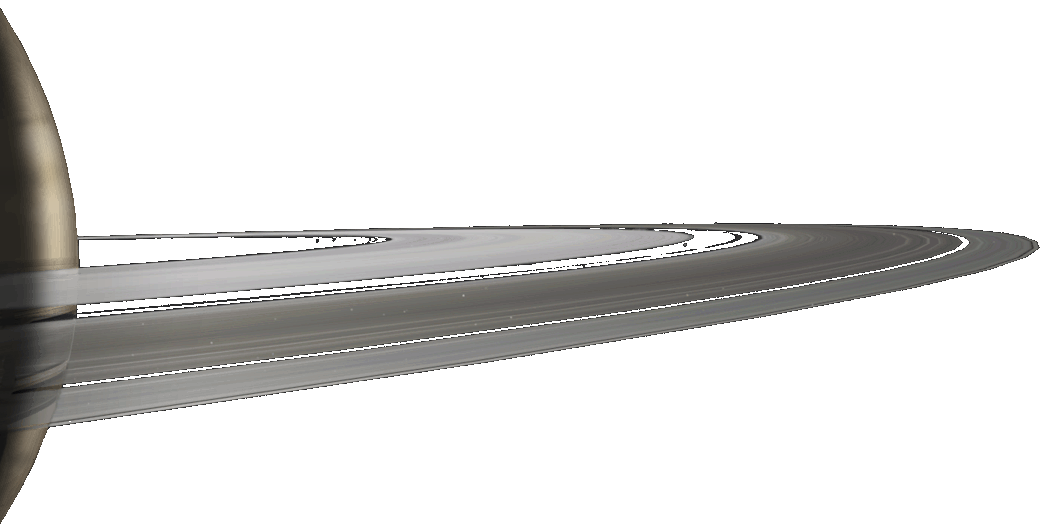




If you could find a big enough ocean to put it in . . .
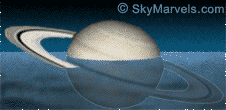
. . . Saturn would float!
Saturn, the "ringed wonder", has the low-
est average density
of any major planet—
lower even than water! This and its rapid spin
make Saturn the most "flattened" major planet! (1.6.x)
(1.4.1)
Saturn, the sixth planet from the Sun, completes one orbit about every 29½ years! (1.6.x) (1.4.1)
Saturn and Earth are
tilted by roughly the same amount to their respective orbits! (1.6.x)
(1.4.1)
CLOUD VIEWS
Like Jupiter, Saturn lacks a solid or liquid "surface". So the ringed planet's "visible surface" is really the top of its elaborate cloud system! Not as multihued as Jupiter, Saturn will one day present us with awesome views! Its incomparable rings, visible through its cloud decks, will arc from horizon to horizon! Enjoy these links to artists' depictions of what we may expect to one day see!
Saturn has some of the fastest winds on the Solar System, much faster than those on Jupiter. 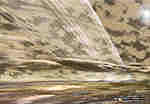
SkyMarvels™ Art © 2013
Here's a transitional region, where the winds of Saturn are considerably more calm.

SkyMarvels™ Art © 2013
And below are a few artist's depictions of Cassini over the cloudtops, advancing toward its "Grand Finale" plunge into Saturn's upper atmosphere!
Here's a treasury of graphics and photos from NASA's Cassini Mission to Saturn. Lots here. Click on MORE button at bottom of its page.
SATURN ACTIVITIES
MAKE A 3-D "CD"
MODEL OF SATURN
NASA's SpacePlace shows how to make a surprisingly accurate CD Model of Saturn
MAKE PAPER MODELS OF SPACECRAFT
Here's an awesome free PDF download that lets you make a cool 3D Paper Model of the Cassini Spacecraft
More 3D Paper Models of Spacecraft From simple to advanced!
Hyperion, moving in the most eccentric orbit of Saturn's major moons, is "locked" in a 3:4 orbital resonance with Titan! ![]()
CELES-TIPS
The following will help you enjoy this page's 1.6.x and 1.4.1 links that run events directly in CELESTIA. If you're new to the program, these tips will also help you learn to use it.
Are you unfamiliar with our 1.6.x and 1.4.1 links? For an explanation click here.
You'll find more information about many of CELESTIA's controls on our Learning Center page.

Saturn
"tips its hat"
to us every
29½ years!
SATURN
View in 3-D Another ![]() 3-D in Orbit
3-D in Orbit
Current Views and Conditions from Earth Major Moons
Current Location in the Constel. Skypath 2025
Current Location in Orbit
Physical Properties:
Equatorial Size: Compare in 3-D
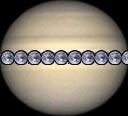
Radius: 60,268 km
Diameter: 120,536 km
Diameter (Earth = 1): 9.449
Rotational Flattening: 0.09796
Mass (Earth = 1): 95.159
Volume (Earth = 1): 763.59
Mean Density (Water = 1): 0.70
Mean Density (Earth = 1): 0.125
Gravity at Apparent "Surface" (Earth = 1): 1.065
Axial Tilt: 26.73° ![]()
(so we see Saturn's rings at different angles
when it is in different parts of its 29½-year orbit)
Where Poles Point ![]()
Rotation Period:
Synodic ("Day" in Earth hours): 10.656
Sidereal (in Earth hours): 10.656
Note: Earth Day Lengths
Mean Solar: 24.0000 hours (24h00m00s)
Sidereal: 23.9345 hr (23h56m4.1s)
Note: different latitudes on the Gas Giants
rotate at different speeds.
Albedo (geometric): 0.47
Magnetosphere
![]()
![]()
Magnetic Field (Earth = 1): 500
Magnetic Polarity: opposite that of Earth
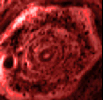 Comparison
Comparison
NASA's Overview of Saturn
Wikipedia page
Saturn Rotating
Polar Hexagon in Infrared
Saturn Structure ![]()
Compared to Other Outer Planets
NASA/JPL-Caltech/SSI Vid:
Mysterious Hurricane at Saturn's North Pole ![]()
NASA/JPL/University of Arizona Vid:
Saturn's Polar Hexagon Structure ![]()
Image Tour: Saturn: from HubbleSite
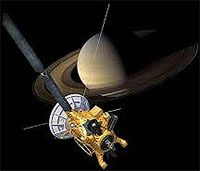 JPL Photojournal
JPL Photojournal
Cassini:
Mission Overview
In 3-D: #1 ![]() #2
#2
Timeline
Inside Saturn's Rings
Grand Finale Scroll down.
Wikipedia page
Ring System:
Yes (a spectacular one!) ![]()
![]()
Wikipedia page
JPL Photojournal Rings Gallery
Cassini Mission Rings Science
Cassini Mission and Rings Gallery
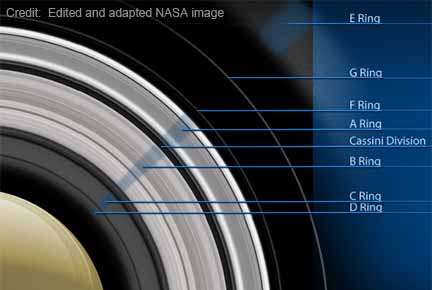 Rings Named in Order of Discovery
Rings Named in Order of Discovery
![]()
Scroll image below to study Cassini's detailed
natural-color mosaic of Saturn's incredible rings.

For more information on this image, click here.
View Saturn's Largest Ring, discovered by SPITZER
![]()
Another View of Saturn's Infrared Ring
![]()
Planet Classifications:
Outer Planet (along with Jupiter, Uranus & Neptune)
Gas Giant (mostly hydrogen and helium)
Superior Planet (has larger orbit than Earth)
Orbit:
(1.6.x)
(1.4.1)
Period: 29.457 Earth years
Distance from Sun:
Mean (Earth = 1 AU): 9.582 AU
Mean: 1,433,530,000 km
Perihelion: 1,352,550,000 km (9.041 AU)
Aphelion: 1,514,500,000 km (10.124 AU)
Velocity:
Mean: 34,884 km/hr
Min: 32,724 km/hr
Max: 36,648 km/hr
Eccentricity: 0.0565
Inclination to Ecliptic: 2.485°
Moons:
Number: at least 146 (more suspected) ![]()
Major Moons: 8
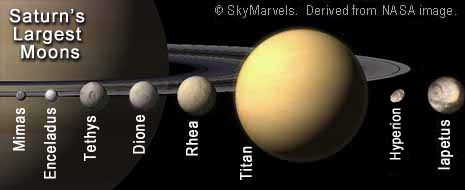
(moons number in billions if you count ring chunks)
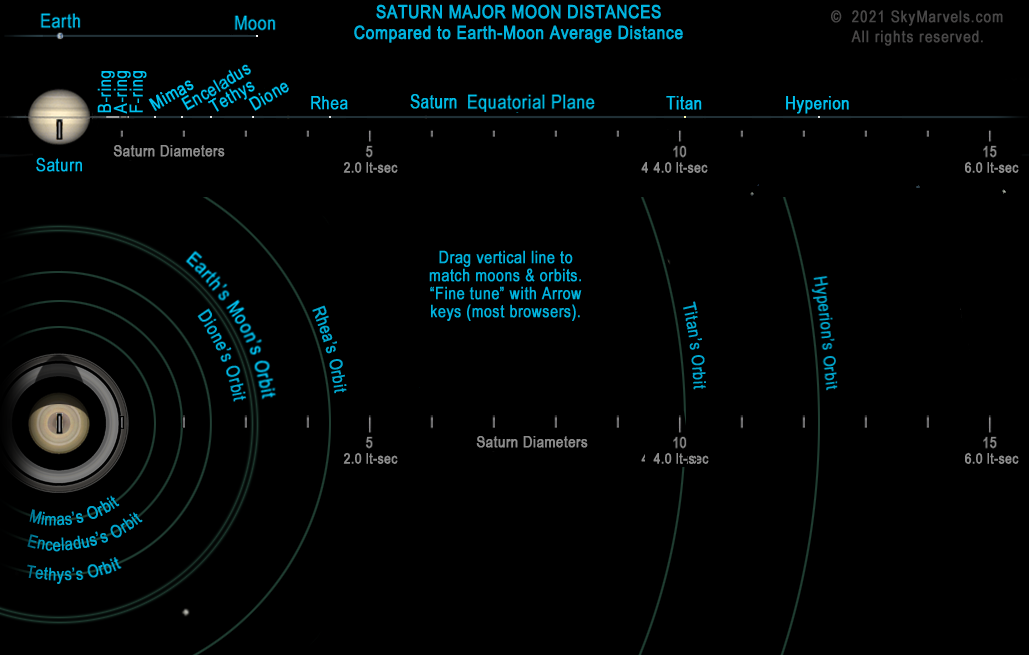
Current Major Moon Positions Viewed from Earth ![]()
Find Current Major Moon Pos. with NASA/JPL Orrery
Opens showing Saturn. Scroll out with mouse-
wheel to see major moons in orbit.
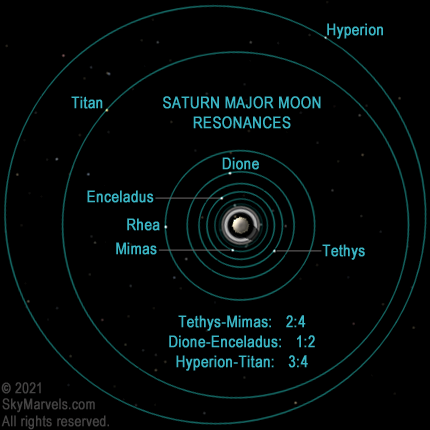
NASA Graphic Of Rings Relative to Inner Moons
Compare to Other Moons
Distances from Saturn
NASA's Saturn Moons Overview
NASA's Icy Moons Treks
Wikipedia's Moons of Saturn page
Mimas
Dimensions: 415.6 x 393.4 x 381.2 km
Rota. & Orb. Period: 0.942 d
Orbital Radius: 185,520 km
View in 3-D ![]()
Mimas Trek Map ![]()
Wikipedia page JPL Photojournal
Enceladus
Dimensions: 513.2 x 502.8 x 496.6 km
Rota. & Orb. Period: 1.370 d
Orbital Radius: 238,020 km
View in 3-D ![]()
Enceladus Trek Map ![]()
Structure ![]() Detail
Detail ![]()
![]() Detail
Detail ![]()
Wikipedia page JPL Photojournal
Saturn and Enceladus Electrical Link
Tethys
Dimensions: 1076.8 x 1057.4 x 1052.6 km
Rota. & Orb. Period: 1.888 d
Orbital Radius: 294,660 km
View in 3-D ![]()
Tethys Trek Map ![]()
Wikipedia page JPL Photojournal
Dione
Dimensions: 1,128.8 x 1,122.6 x 1,119.2 km
Rota. & Orb. Period: 2.737 d
Orbital Radius: 377,400 km
View in 3-D ![]()
Dione Trek Map ![]()
Wikipedia page JPL Photojournal
Rhea
Dimensions: 1,532.4 x 1,525.6 x 1,524.4 km
Rota. & Orb. Period: 4.518 d
Orbital Radius: 527,040 km
View in 3-D ![]()
Rhea Trek Map ![]()
Wikipedia page JPL Photojournal
Titan: Saturn's Largest Moon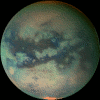
Mean Diameter: 5,149.5 km
Rota. & Orb. Period: 15.945 d
Orbital Radius: 1,221,830 km
Compare to Earth and "our" Moon
View Surface in 3-D (b/w) ![]()
Titan Trek Map 1 ![]() Map 2
Map 2
Map 3
w/Labels ![]()
Structure
![]() Detail
Detail
![]()
Atmosphere Compared to Earth's Titan in Infrared
Wikipedia page JPL Photojournal
Huygens Descent to Titan
![]()
Titan Touchdown
![]()
Hyperion
Dimensions: 360.2 x 266.0 x 205.4 km
Rota. & Orb. Period: 21.277 d
Orbital Radius: 1,481,100 km
View in 3-D ![]()
Wikipedia page JPL Photojournal
Iapetus
Dimensions: 1,492 x 1,492 x 1,424 km
Rota. & Orb. Period: 79.330 d
Orbital Radius: 3,561,300
View in 3-D ![]()
Iapetus Trek Map ![]()
Wikipedia page JPL Photojournal
Shepherd Moons ![]()
Wikipedia page
Partial Information Source: NASA Fact Sheets
SATURN'S SWARM OF MOONS
ADJECTIVES MEANING
"pertaining to Saturn"
Saturnian
Cronian (from Greek god, Cronus)
EQUINOX AT SATURN
video credit: NASA
"CASSINI-HUYGENS: Mission to Saturn" Poster
image credit: NASA/JPL-Caltech
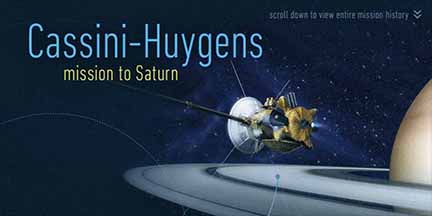
NASA's Voyager Mission Overview
Home Intro News Gallery Sky-Gifts Bonuses Tips
Learning Ctr Help Links Credits Legal Contact Us
© 2007-
by Gary M. Winter. All rights reserved.
Interested in political cartoons and humor?
Check out The HIPPLOMATS™.
SkyMarvels, Sky Marvels, SkyMarvels.com, celestia4all, celestiaforall, CELESTIA, astronomy, space, simulations, animations, downloadable astronomy posters, stars, planets, Inner Planets, Outer Planets, Inferior Planets, Superior Planets, moons, asteroids, comets, Oort Cloud, galaxy, galaxies, Milky Way, Andromeda, globular clusters, binaries, quasars, black holes, supermassive black holes, telescope, telescopes, planetarium, software, freestuff, satellites, add-ons, addons, scripts, eclipses, Solar Eclipses, Lunar Eclipses, Solar Eclipse Finder, Lunar Eclipse Finder, mutual eclipses, transits, occultations, Solar System, CELES-TOOLS, celeSTARrium, CELX, CELX programming, Freebies, Bonuses, multiple views, atronomical unit, light year, parsec, meteors, meteor showers, Perseids, Geminids, Leonids, barycenter, time, Time Zones, tides, alignments, conjunctions, oppositions, seasons, apogees, perigees, aphelion, perihelion, Earth, Luna, Mercury, Venus, Mars, Jupiter, Galilean Moons, Io, Europa, Ganymede, Callisto, Saturn, Titan, rings, Uranus, Neptune, Triton, E-MSpectrum, electromagnetic spectrum, astronaut, equinoxes, solstices, precession, rotation, spin, inclination, tilt, Ecliptic, orbits, ellipse, parabola, hyperbola
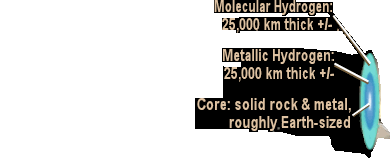
Donate safely with: PayPal
and receive one or more
Sky-Gifts. Your support is greatly appreciated!
NOTE: you do not need a PayPal account to donate.
SKY VIEWING
SOLAR SYSTEM
THE SUN
MERCURY
VENUS
EARTH
THE MOON
MARS
JUPITER
SATURN
URANUS
NEPTUNE
SMALLER WORLDS
STELLAR OBJECTS
EXOPLANETS
DEEP-SKY OBJECTS
SCALE OF THE COSMOS
———————
SKY-FUN / SKY-GAMES
NASA's LATEST
SATURN CASSINI Location and Status
SATURN FUN FACTS
On average, Saturn is less dense than water! It would float—that is, if you could find a bathtub big enough to put it in!
Saturn's rings are beautiful, so beautiful that one of the planet's nicknames is the "Jewel of the Solar System!"
The total mass of Saturn's rings is thought to be about the same as the mass of the planet's small moon Mimas!
The constituents of Saturn's rings range from a countless number of dust-sized specks to a scattering of mountain-sized objects!
Titan is the 2nd largest moon in the Solar System and the only moon with a dense at- mosphere!
SATURN INTERACTIVES
QUICK ACCESS LIST
Note: some links are echoed elsewhere on this page and may include descriptive text.
Spacecraft in 3-D:
Voyager
Cassini
Links to interactive features that show Saturn's orbit in 3-D can be found on our Solar System page
HubbleSite's Image Tour: Saturn
Cassini-Huygens Mission to Saturn Poster
Saturn Viewer Find the tilt of Saturn and its rings, and the location of its major moons, for any time and date.
Saturn Moon Tracker lets you generate and download diagrams of the locations of Saturn's major moons and rings over spans of time.
Most of Saturn's major moons—and most com- ponents of its spectacular rings—orbit nearly in its equatorial plane and in nearly circular orbits!
ELEMENTS OF SATURN'S MAJOR MOON ORBITS
| Period (Earth Days) |
Orbital Inclin- ation |
Radius (103 km) |
Eccen- tricity |
|
|---|---|---|---|---|
| Mim | 0.942 | 1.53° | 185.52 | 0.020 |
| Enc | 1.370 | 0.00° | 238.02 | 0.005 |
| Tet | 1.888 | 1.86° | 294.66 | 0.000 |
| Dio | 2.737 | 0.02° | 377.40 | 0.002 |
| Rhe | 4.518 | 0.35° | 527.04 | 0.001 |
| Tit | 15.95 | 0.33° | 1,221.8 | 0.029 |
| Hyp | 21.28 | 0.43° | 1,481.1 | 0.104 |
| Iap | 79.33 | 14.72° | 3,561.3 | 0.028 |
Light requires about
4 seconds to travel
from Saturn to Titan!
Relative to the Ecliptic, Saturn and the orbits
of its seven inner major moons are tilted about
as much as Earth, Mars
and Neptune ![]()
![]()

Unlike Saturn's seven inner major moons, Iapetus—which orbits at over twice Hyperion's distance—strays far
from the ringed planet's equatorial plane.
SATURN'S EQUINOXES
As each planet moves through the Solar System, twice during each orbit its equatorial plane aligns with the Sun. From a planet's own perspective, this is when the Sun moves across its celestial equator in its sky, and the planet's Northern and Southern Hemispheres are il-luminated equally.
Saturn's equinoxes occur a bit less than every fifteen years. At such times the planet's in- comparable rings appear al- most invisible from Earth, as they are "edge on" to the Sun and lit very little by it. They are also nearly "edge on" to us here on Earth. Because most of Saturn's major moons orbit nearly in its equatorial plane, the conditions most conducive to producing their multiple and mutual eclipses always occur near the planet's equinoxes. Saturn's last equinox occurred on 2009 Aug 11, while it next will occur on 2025 May 6.
SKYMARVELS™
POSTERS FEATURING SATURN
SKYMARVELS™
VIDEOS FEATURING SATURN